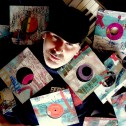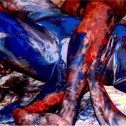The Art of Glastonbury Today
As featured in England’s West Country Life magazine and the Western Daily Press. To view this article in the UK’s printed press click here: Glasto with Gabriella
As Glastonbury 2011 celebrates 41 years of good times, great bands, and ticket sell-outs, it is difficult to imagine that all those years ago the then-one-day event only cost £1, which got you some free milk from the farm to watch the few key acts that were Marc Bolan, Al Stewart and Quintessence.
The very first Glastonbury Festival of 1970 was in fact held on the day after Jimi Hendrix died. Run by the Eavis family, in particular dairy farmer Michael Eavis and his daughter, Emily, the fate of the festival’s venue followed Michael Eavis’ father’s death in 1958 when Michael returned to the Glastonbury site to inherit the family farm totalling an area of 150 acres that grazed 60 cows. Inspired by Led Zeppelin’s performance at 1969’s Bath Festival of Blues, Michael Eavis decided to host a festival of his own the following year. And the rest, as they say, is history. Set upon these acres and acres of England’s pleasant pastures, (no cross-reference to Hubert Parry’s Jerusalem hymn intended; ok, well, maybe a little), the festival’s West country venue is admittedly idyllic for the heavenly bliss that so many music fans experience here, year upon year. Not to mention, Glastonbury Abbey. Many a sunrise has been enjoyed by fans camping out on England’s mountains green (yes, I did it again), light streaming in to hung-over eyes from behind the majestic silhouette of the ruins of Glastonbury Abbey, one of Britain’s most important archaeological sites. Its Christian history stretches back 2000 years and it is the legendary burial place of King Arthur. In the 16thCentury the magnificent Abbey was ransacked during Henry VIII’s dissolution of the monasteries and abandoned, but today it remains an integral part of England’s history and acts as an everlasting landmark, not to mention a photographic favourite for those capturing the spirit of the place and its proud past.
Before long “word had got around” that Eavis had held a festival at this farm. By its second year in 1971, attendee-numbers had already boosted up to 12000.
Today, Glastonbury is arguably the world’s biggest music festival of its kind. Last year saw over 40,000 attend the event whilst this year’s ticket prices are over £185 for three days of acts in their abundances with an overload of choice and Earth-moving vibes, the amps of which must surely rock the planet to its core and jolt it off its axis at the best of times. As every attendee is sure to admit, Glastonbury is actually not a bad health-incentive, considering the amount of running involved from one field to the next, in a mission-impossible attempt to cram the hundreds of acts in to those precious 72 hours. Omnipresence is sadly not possible in this life and so I will summarise it mildly on behalf of everyone by saying that it is a challenge. This year’s line-up includes U2, Coldplay. Beyoncé, Paul Simon, Paolo Nutini, Chemical Brothers, Queens of the Stone Age, Fatboy Slim, Primal Scream. The old favourites are still as popular as they were back in the day and this year once again sees the return of BB King, The Crazy World of Arthur Brown, Don Mclean, Duane Eddy, Raul Malo from the Mavericks, Nick Lowe and Shangri-La. The splendour of Glastonbury is all ages joining the ritual.
We are also being introduced to the “Glastonbury Firelighter Daily Newspaper” this year, presumably a paper you read and then burn to create bright and pretty light-trails at night with some great waste disposal management in the process.
In short, Glastonbury Festival is often described as a “small village” and community in itself, consisting not just of music, but also performing arts, children’s activities and the popular ‘healing fields’.
@GlastoFest is the official Twitter Page reaching over 73,000 followers whilst @Glastowatch will be providing a live ongoing stream of ‘Glasto’ news as it happens, but the discussion has already started. In fact, the discussion never ends. It continues all year round. People plan their annual diaries around it and die-hard fans plan their entire lives around it. For it is a pilgrimage. References to William Blake’s apt old English verse spring to mind once again in the joy of the event and even extend to the festival’s website:
“For everything that lives is holy,
life delights in life,
Because the soul of sweet delight
can never be defil’d.”
It is important to note at this point that it is not just about the booze, camping spirit and great music, but it has grown to be a culture, a religion; a way of life. Glastonbury throws its arms around the world as the crowd come together, supporting Greenpeace, Water Aid, Oxfam and other worthwhile causes whilst its Hiroshima Peace Flame has been burning since 1946.
And now, art is coming to Glastonbury and it’s bigger than ever before. Internationally-renowned fine art photographer Barry Cawston from Axbridge in Somerset who spring boarded his growing success even further on BBC 2’s Show Me The Monet show recently called me: “I’ve got the caravan packed up: are you going, Gabriella?” I regret to inform him that I shan’t be there as I have a date with some strawberries and cream at Wimbledon. Barry exclaims “This is our fourth one. Soraya [Barry’s partner and fellow artist] and our daughter, Lyla love it!” Lyla is 5 and it is her third time to Glastonbury. Asking Lyla how she would describe the Festival in three words, she replies “Fun, fun, fun. Oh and magic!” “It’s a great family time for us” Barry explains. “And my art is all packed and ready to go with us.” Barry is in fact showcasing two of his pieces at this year’s Festival for all to see. He says these pieces are the most “difficult pictures ever taken” in his entire photographic career. But it’s paid off and their quality is stunning. “Muse and the Moon” was shot on a large format camera and is a compilation of seven 5/4 megabytes to produce a gigabyte file. It has been printed on five panels, by Latent Light who are sponsoring the exhibition, on five 4ft x 3ft panels in the Dance area. Barry took this glowing shot at last year’s 40th anniversary Glastonbury Festival on the Saturday night during Muse’s first song of their gig on the Pyramid stage.
Barry laughs and admits “I was literally hanging onto the tripod and the fence below Michael Eavis’s farm. I had to reset the camera each time, focus and move it around to take the panoramic. It was technically one of the most difficult pictures I have ever taken and I had of course slept only periodically since I arrived on the Wednesday. But Muse sounded amazing and the view was of a city of gold. As a finished piece I just love the detail and the chaotic nature of the tents complete with a just-married sign and because each exposure was over 20 seconds long, the movement of the lanterns and the crowds when viewed at 20×3 ft adds a surreal quality.”
“Sundown in the Park” is another panoramic, light, bright and hopeful in spirit. Barry tells me: “This one was taken at around nine o’clock on the Friday night at the top of Emily Eavis’s Park area as the sun was setting. Everyone was chilling before the big night ahead. It just shows how vast the whole event and experience is.”
He continues “Malcolm Haynes, who runs the Dance Field, said to me last year, “Right Barry: you are a photographer. How many pictures did you take of Glastonbury last year?” He assumed I had taken thousands in this digital age, but I had in fact only taken two. And he has very kindly let me exhibit them. I hope people come down to see them. The aim of them is also to help people work out where they actually were last year!”
What is quite apparent and equally addictive about both panoramic shots is their phenomenal detail, causing one to go back to them again and again and discover more each time: a lot of hard work and meticulous compositional thought has evidently gone into these fine art photographs and I am confident that the crowd are going to love them.
“I am hoping to take two more panoramas this year to build up a series for Glastonbury’s 50th anniversary” Barry says. “I am also going to give away a 4x1ft print of each to someone who tags ‘Like’ on the photographs on my Facebook page and I am also going to donate a print of each to Oxfam and the Festival.”
As I wish Barry and his family a great time at this year’s ‘Glasto’, he reflects and concludes: “It’s like being at sea. I’m not sure why: perhaps because it changes when the heavens open.”

Sundown in the Park. The full version in full detail will also be available in the Dance area of this year’s Glastonbury Festival June 22nd, 23rd and 24th 2011

Muse & the Moon, the large version of which will be on display in the Dance area at next week’s Glastonbury Festival June 22nd, 23rd and 24th 2011
© The Culture Cave 2011. All rights reserved








